Create a Potent Yoga Practice for Every Individual: The Art and Science of Sequencing
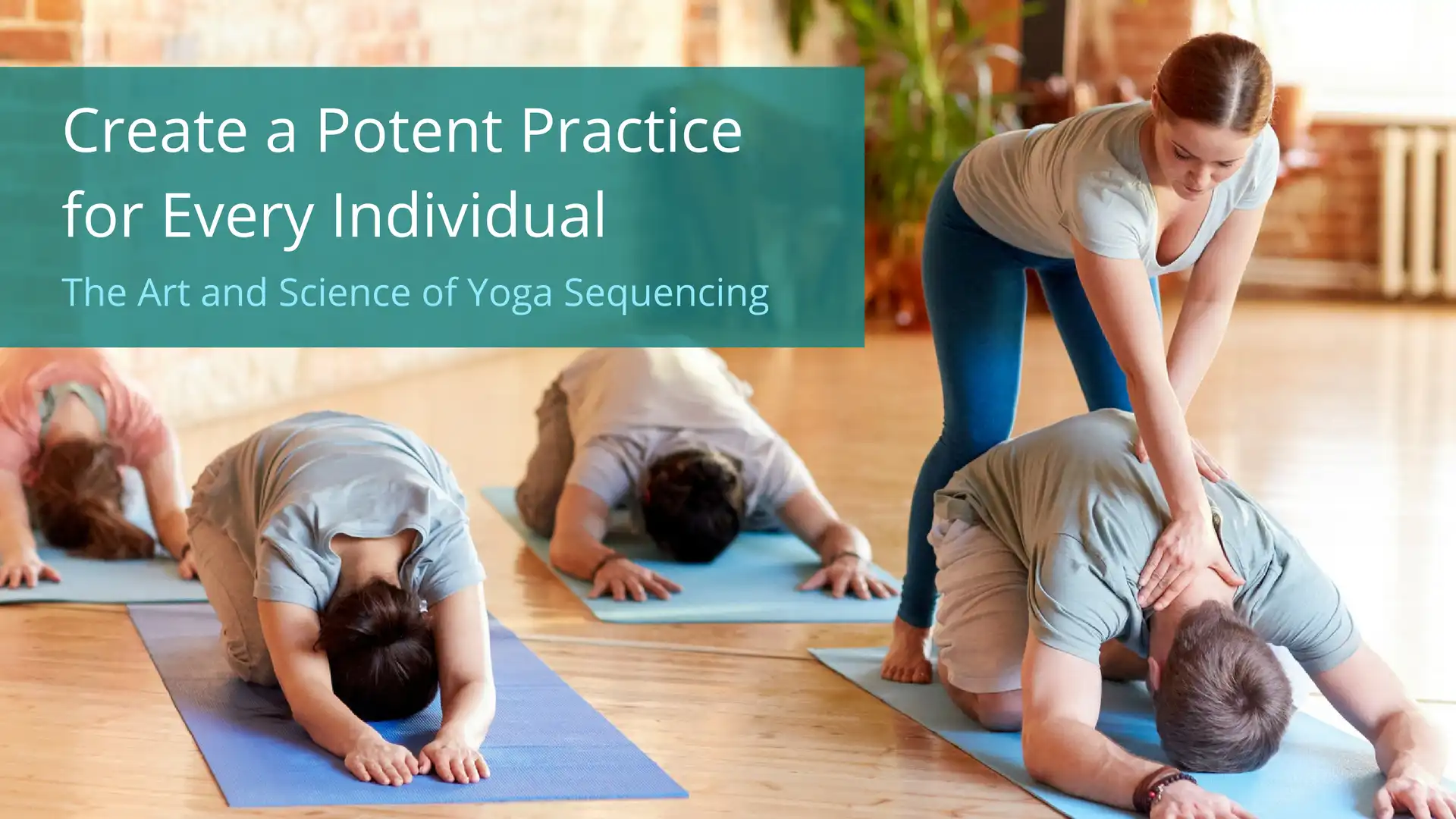
I remember hating Latin in college. Unfortunately, it was required for my degree, so I had to endure. For example, translating a Latin sentence takes a lot of work because there is quite a bit of flexibility in word placement; it was hard to know if “Claudius stabbed Dionysus” or the other way around. So you had to pay attention to grammatical nuance to figure out what was going on.
Yoga sequencing is similar to Latin in some ways. Here, too, you have many different elements (poses, breathing practices, etc.) that could be arranged with great flexibility and produce an entirely different result. Therefore, being a yoga teacher is not only about knowing how to do a pose, but also where to place it in relation to other poses to produce the desired effect and minimize the risk.
There is an art and science to yoga sequencing. When we think of science, we think of logic. Science is something that can be rationally explained and is systematically organized. The “science of yoga sequencing” refers to the body of knowledge generated over hundreds of years and strategies for arranging various yogic tools into a logical, potent practice. These principles and guidelines on how to select appropriate practices and why to combine them in a certain way are clearly articulated in the Krishnamacharya/Desikachar teaching lineage.
Begin with Who, Why and Where, and Then, What and How:
- Who: the practitioner and his/her specific needs, goals and preferences; the student
- Why: Why are you teaching this practice, what are you trying to accomplish; your intention
- Where: Where will the practice take place and when; what is the context?
- What: What are you planning to teach; content
- How: How do you present it to your students; method
“The teacher who is learned, reflective and disciplined should apply yoga appropriately, only after considering the time, place, age, activity and strength of the student” – Yoga Rahasya of Nathamuni 1:30
Let’s use some simple examples. There is a group of three poses that I love, I call them “the magic three.” They are magic because almost anybody can do them and most people would benefit from them.
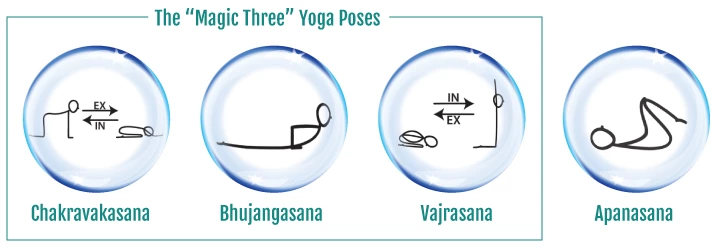
Let’s use those three poses (Chakravakasana (Cat/Cow Poses), Bhujangasana (Cobra Pose), Vajrasana (Diamond Pose) plus Apanasana (Knee to Chest Pose) to show how we can adapt their form and rearrange them within a sequence to achieve completely different results. For that, we will use three hypothetical clients that are loosely based on some of my former clients.
Meet Jill. She is in her 40s, works from home and spends a lot of time in front of her computer. She also takes care of her sick mother, so she doesn’t have much time to go to yoga classes. She needs a short routine to do on her own. She is worried about sitting too much during the day and feels stiffness in her hips and back when she gets up. She also experiences an afternoon energy “slump,” where she has a hard time focusing on her tasks and feels lethargic.
Here are some suggestions that we can give Jill: 
- Alternate sitting and standing at the desk
- Take short, frequent walking breaks (at least every hour)
- Integrate deep breathing while she walks
- Do the following short yoga practice to do around 2.30 pm, right around the time her afternoon slump is about to hit.
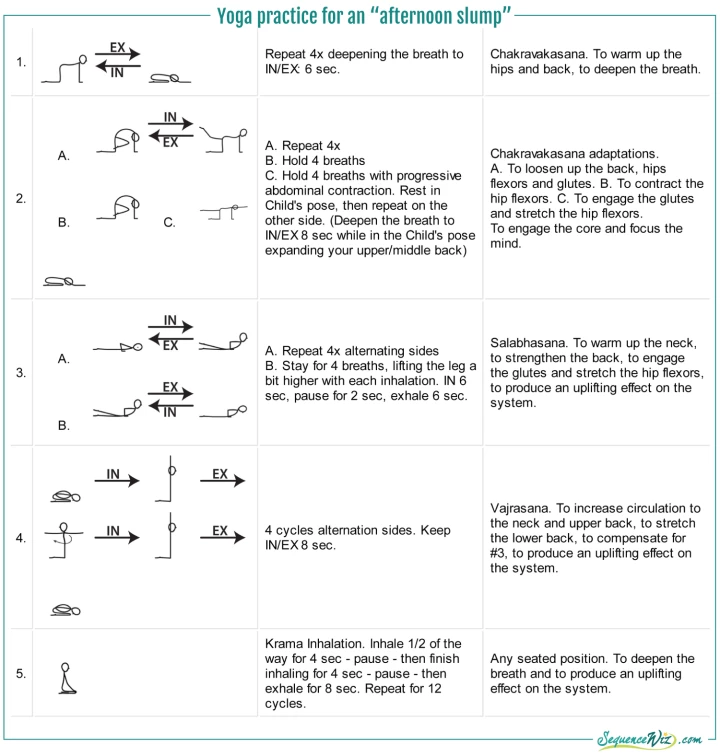
Here is Anna. She is a new mom to a 6-month-old son; she is always on the go from one thing to the next, often with the baby on her hip. She worries about his health and safety to the point that she sometimes feels shortness of breath. She has anxious energy around her and she feels that she can only spare a few minutes of yoga before she goes to bed. She is exhausted by the end of the day, but has trouble sleeping because she keeps listening for the sounds from the baby’s room.
For Anna, we would have the following recommendations: 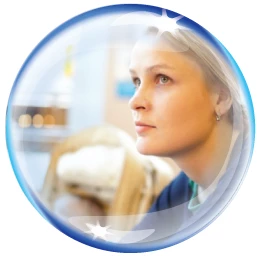
- Take more time for herself, get out more without the baby
- Get a support system in place–friends, family or other moms
- Do deep breathing while she breastfeeds (tying the breathing practice to a specific activity)
- Try this short practice before bed paying specific attention to the breath
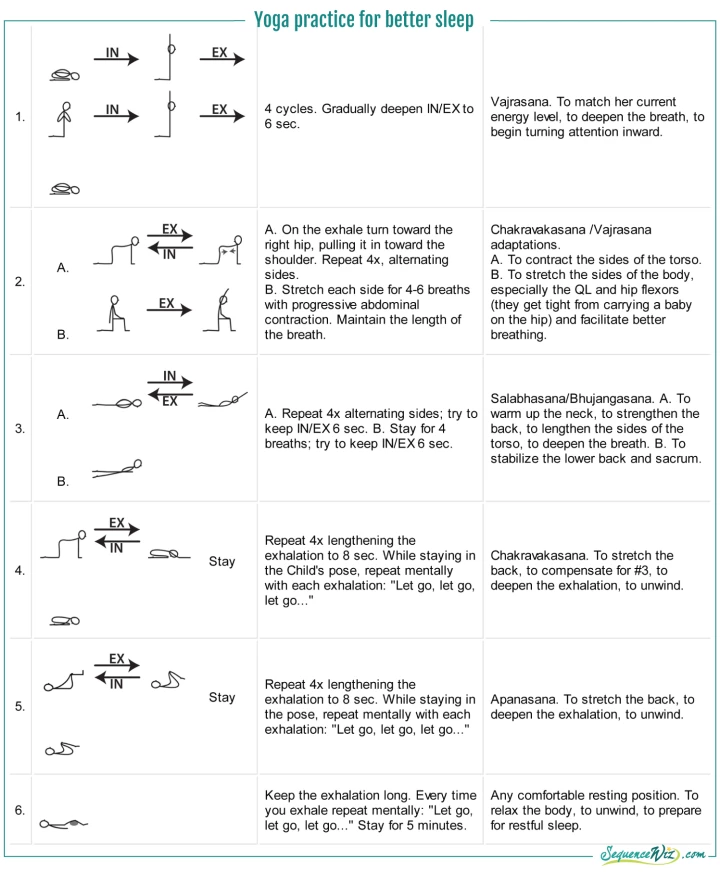
Jim is a construction worker who spends most of his day on his feet doing physical labor—lifting, leaning and hauling heavy things. He got into a habit of popping a couple of Advil every morning because his lower back and his knees feel so stiff. He doesn’t want to be dependent on the meds and is looking for other ways to “limber up” in the morning. His morning energy isn’t great either. It takes him a while to get going.
For Jim, we would recommend that he: 
- Pay attention to proper lifting technique while at work
- Go to bed earlier to get more rest (if this is not enough, we would need to explore other options to help him sleep better)
- Start his day with the following short practice while still in bed, as soon as he wakes up, and then gradually transition to sitting in bed, and then to the ground.

As you can see, each practice is meant for the needs of an individual student, taking into consideration who she is, why she needs yoga, when and where she would be able to practice and what would work for her. And even the practices made of the same four poses can be adapted to meet the needs of three very different students, if we choose appropriate pose adaptations, arrange them according to the students’ needs, and use relevant breathing practices.
“A well-conceived sequence is the key to an effective practice. Such a sequence has the qualities of order, harmony, and efficiency throughout, each posture and adaptation being selected and placed purposefully to create an integrated whole.” – Gary Kraftsow, Yoga for Wellness
The science of yoga sequencing refers to specific guidelines on yoga practice design, while “art” implies the use of skill and imagination. The art of yoga sequencing is built on the inspiration and creativity of the teacher; it uses subtle details to breathe life into the practice. It includes the teacher’s ability to make the practice relevant to the student and to help her discover something new about herself. The art of sequencing comes from the clear, receptive mind of the teacher and grows with experience. Therefore, a skillful sequence is not just a logically arranged set of yoga poses, but a practice that has a positive impact on a practitioner, whether it’s physical, physiological or mental-emotional.
Both our theoretical understanding and creative skills are essential in yoga practice design. These take time to develop. If you study the teachings and apply the principles in your personal yoga practice and in your work with the students, you will notice that your practices become more refined, harmonious and relevant.
In my school years, I eventually became fascinated with Latin. I came to view it as an intricate puzzle that, once solved, would reveal inner depth, complexity, and elegance that I haven’t seen before. Your yoga practices have the potential to do the same.
If avoiding injuries and informed alignment is important to your practice – Study with Olga Kabel and YogaUOnline – Avoiding Yoga Injuries: Common Alignment Mistakes with Backbends and Lateral Bends.
Reprinted with permission from sequencewiz.com

Educated as a school teacher, Olga Kabel has been teaching yoga for over 14 years. She completed multiple Yoga Teacher Training Programs but discovered the strongest connection to the Krishnamacharya/ T.K.V. Desikachar lineage. She had studied with Gary Kraftsow and American Viniyoga Institute (2004-2006) and received her Viniyoga Teacher diploma in July 2006 becoming an AVI-certified Yoga Therapist in April 2011. Olga is a founder and managing director of Sequence Wiz- a web-based yoga sequence builder that assists yoga teachers and yoga therapists in creating and organizing yoga practices. It also features simple, informational articles on how to sequence yoga practices for maximum effectiveness. Olga strongly believes in the healing power of this ancient discipline on every level: physical, psychological, and spiritual. She strives to make yoga practices accessible to students of any age, physical ability and medical history specializing in helping her students relieve muscle aches and pains, manage stress and anxiety, and develop mental focus.




